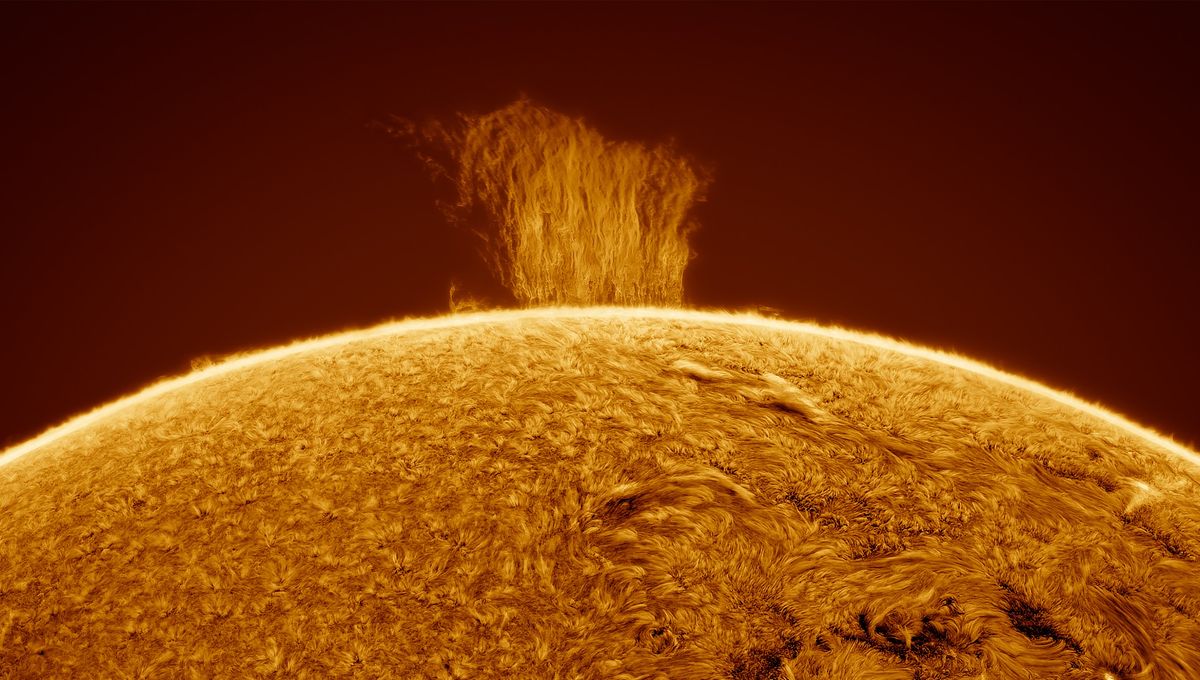
The Sun is heading towards the peak of activity in the current cycle, the solar maximum, which means more potentially concerning space weather events but also more stunning features forming on the surface of the Sun. The latest one, a towering Polar Crown Prominence (PCP), has been captured in exquisite detail by an astrophotographer in Argentina.
Eduardo Schaberger Poupeau snapped the stunning picture on March 9, and it is truly magnificent. The plasma veil towers 100,000 kilometers (61,000 miles) over the surface of the Sun. That’s over a quarter of the distance between Earth and the Moon. He was tipped off of to the presence of this feature by the National Solar Observatory Global Oscillation Network Group and set out to take a good picture battling the heat wave and drought in his area, which makes the atmosphere dusty and turbulent. Using his most powerful telescope, he obtained something spectacular.
“I was determined to get a good shot, so I quickly set up my equipment in my backyard and used my most powerful telescope to get a better view,” Schaberger Poupeau told IFLScience.
“The vision I had on my laptop screen was truly incredible, being able to observe those hundreds of plasma threads dripping down a 100,000 km high wall literally left me speechless. I spent about two hours taking pictures, trying to find moments of greatest atmospheric stability to get the best possible result.”
PCPs, a subtype of solar prominences, are fairly common features on the Sun. Usually, solar prominences are beautiful loops of incandescent plasma stretching from the photosphere into space and back down again. PCPs, however, don’t tend to loop, and until relatively recently they were believed to be almost static. It was observations from the Japanese Hinode spacecraft taken 15 years ago that showed how active they are.
These features are found between 60 and 70 degrees of latitude on both hemispheres of the Sun and they can end up circling the polar regions, which is why they are referred to as a crown. PCPs, like other prominences, are shaped by magnetic fields. Following the magnetic field lines, the plasma in this feature flows back down onto the Sun like a waterfall.
“Taking pictures of the sun is always super exciting for me. Every day, I am fascinated by the changing details on the sun’s surface, the movement of sunspots as they travel along with the solar rotation, and the transformations of filaments or sudden flares in active regions,” Schaberger Poupeau told IFLScience.
“While gratifying, this pursuit is also complicated and requires a great deal of patience. The quality of the sky plays a crucial role in obtaining good results, and I often must wait for long periods to capture the few moments of stability in the atmosphere necessary to produce the images.”
As Schaberger Poupeau noted, astrophotography is also a matter of having the right equipment with the right filters to capture the right wavelengths of light emitted by the Sun. Consistency is also crucial to get the type of incredible shot Schaberger Poupeau managed here. But nobody can really argue with the results.
Source Link: Extraordinary Photo Shows A Wall Of Plasma Towering Over The Sun